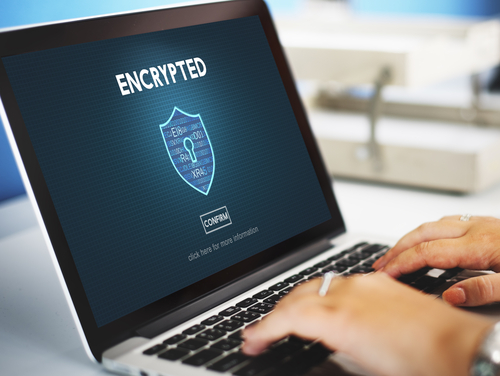Have you ever received an email that looked like it was from a friend or company you know, but something seemed a little off about it? Maybe it was asking for sensitive information or had strange links in it. This is something called email spoofing, where a sender disguises who an email is really from.
In this article, we’ll explain what email spoofing is, how it works, and some tips to help protect yourself from falling victim to a spoofed email.

What Is Email Spoofing?
At its core, email spoofing is a technique employed by cybercriminals to deceive recipients into believing that an email comes from a legitimate source when, in reality, it does not. On the surface, it appears the message came from someone you know and trust, like a friend, co-worker, or company.
In reality, a different person sent it. Think of it as a digital disguise – hackers wear a mask, pretending to be someone else, whether a trusted individual, a reputable organization, or even a governmental entity. Spoofing works because email functions by simply displaying names and relying on the honor system – there’s no built-in way to verify the authenticity of a sender’s claimed identity.
Hackers take advantage of this limitation to cover their tracks and appear legitimate to unsuspecting users.
How Does Email Spoofing Work?
The core of email spoofing involves altering the “From” address in the email header. This part of the email typically displays the sender’s name and email address. Cybercriminals change this information to make it look like the email is from a trusted or legitimate source. They can use any spoof email address they desire.
When a user composes an email, their client software packages it up along with headers that include technical details like the message ID, the path of servers it traveled through, and, crucially, the source (From) and destination (To) addresses.
On the flip side, when a spoofer creates an email, they can edit the header’s “Return-Path” and “From” fields before sending to display any address they choose. This tricks the recipient’s email client and server into thinking the email came from that spoofed address rather than the actual computer it originated from.
The email header’s “Return Path” field is used to specify where bounce-back messages and delivery notifications should be sent. Email spoofers can change this field to redirect any undeliverable or error messages to their own server, ensuring that the recipient doesn’t receive such notifications.
Once the email header has been manipulated to appear legitimate, the email spoofer crafts the message itself. They can use social engineering tactics to make the recipient believe the email is urgent or important, increasing the likelihood of the recipient taking the desired action, such as clicking on a link, downloading an attachment, or revealing sensitive information.
The Motives Behind Email Spoofing
Email spoofing is not a one-size-fits-all cyberattack. Instead, it is a versatile tool in the cybercriminals’ bag of tricks, allowing them to carry out various malicious activities. Here are some of the primary motives behind email spoofing:
Phishing
One of the biggest motives for spoofing is to enable phishing scams. Scammers can mislead you into a false sense of security by making an email appear from a legitimate and trusted source, like a bank or retailer. This can trick you into letting your guard down.
Once you believe the spoofed email is genuinely from the disguised organization, you can more easily fall victim to the phishing trap laid within. They can craft links and attachments to steal your login details or infect your devices with malware.
So, all the spoofing does is masquerade as the bait to draw you in. The real payoff comes when you take the phishing bait, like clicking a link and providing personal data the scammer wants.
Malware Distribution
Spoofing opens the door for malicious attachments or links in emails. When people let their guard down, thinking an email is truly from a friend or company they trust, they may be more likely to download viruses or ransomware unwittingly.
Of course, no legitimate organization would intentionally infect their customers. But by posing as such, spoofers capitalize on your existing relationships to compromise you. Their goal is to exploit trust to stealthily deploy harmful code remotely.
Business Email Compromise (BEC)
This type of scenario is unfortunately all too common these days. Known as Business Email Compromise or BEC, it sees scammers pose as company executives or vendors to trick employees into wiring money.
Fraudsters often spoof the emails of CEOs or partners, crafting messages asking staff to send payments due to “changed banking details urgently.” They disguise their identity and try to exploit the routine trust between organizations. If employees don’t verify, funds can vanish in an instant. These BEC attacks can result in significant financial losses for businesses.
Spamming and Scams
Email spoofing is also used to send large volumes of spam emails or promote various scams. So, if you’ve ever noticed many emails promoting weird products or miracle cures claim to come from your friends, chances are they were spoofed.
Many spoofs also impersonate celebrities and influencers pitching cryptocurrencies, work-from-home opportunities, or other sketchy deals. These con artists aim to deceive recipients and avoid suspicion of their dubious offers.
Political and Ideological Motivations
Unfortunately, some see email spoofing as another tool for their misguided agendas. Certain activists or radical groups may use it to broadcast distorted “facts” promoting their cause or smearing opponents. They use this technique to disseminate false information, spread propaganda, or launch attacks on rival organizations, governments, or individuals with opposing views.
While their motives might come from a place of passion, manipulating public opinion through deceit tends to do more harm than good.
Identity Theft
We’ve all received tax documents or package shipping notifications claiming to need updated address verification. But did you really order anything, or is a thief masking their intent to steal your private records through impersonation?
By gaining access to sensitive information through spoofed emails, these cybercriminals can steal your identity, commit financial fraud, or engage in other illegal activities on your behalf.
Information Gathering
Sometimes, email header spoofing may be part of a larger reconnaissance effort. Hackers may impersonate colleagues to subtly map how companies work – who’s in what role, who talks to whom, what kinds of requests get processed, and how.
By sending subtle “information-gathering” emails under the pretenses of interoffice questions or support issues, they can start to picture a business’s lay of the land without tripping too many alarms. This information can be used to plan more targeted and sophisticated attacks in the future.
Spoof vs. Phishing
While email spoofing and phishing both use deception, there is an important distinction between the two. Spoofing simply involves manipulating email headers to disguise the real sender’s identity by masquerading as someone else. The goal is impersonation rather than eliciting a response.
Phishing, on the other hand, relies on crafting misleading messages, usually containing links specifically designed to trick the recipient into taking action, such as clicking and providing sensitive details. While phishing messages may also spoof sender addresses to add perceived legitimacy, the primary purpose is to exploit human trust and psychology. Therefore, you can say that phishing results from spoofing, as earlier mentioned.
Spoofing Email Example
A typical example of spoofing is that you might receive an email that looks like it’s from your credit card company, Visa. The subject line might say, “Urgent: Suspicious activity on your account.”
The email might display Visa’s logo at the top and look very official, probably even referencing your last four credit card digits. However, it stated there had been $1,000 in charges that day at Best Buy that you didn’t make.
It might instruct you to click a link to dispute the transactions. The link will take you to a website that mirrors Visa’s design and requests that you re-enter your full credit card number, CVV code, and expiration to “freeze your card during the investigation.”
However, it seems odd that Visa would ask for all that on a random website. So, you logged into your actual online Visa account instead, and nothing was wrong. This is clearly a case of spoofing – someone faking the “From” address as Visa to try and trick you into a phishing site to steal your card details.
How Do I Know My Email Is Being Spoofed?
Detecting whether your email is being spoofed can be challenging, but there are several signs and techniques you can use to identify potential email spoofing incidents:
Unusual Domain
If an email raising red flags claims to be from a bigger company, do some digging to check if the domain checks out. Quickly search the supposed sender’s domain name to see if it leads back to the company’s website.
Legit domains should pop up normal search results about the company, while fake ones may redirect strangely or have no online footprint. Trusted brands also generally list their authorized email domains publicly. It’s also helpful to check domains against databases of known phishing or spoofing addresses kept by tech security groups.
Unusual Content
Pay attention to how emails are written. Fake ones can give themselves away through weird wording or just sounding “off.” Misspellings, odd grammar, or stilted phrasing are all red flags – it’s a dead giveaway the sender isn’t a native English speaker sometimes. Even big companies make typos, but multiple errors get suspicious.
Watch for emails asking you to do strange things you’ve never heard of before. Like if your credit card company suddenly needs your social or passport scanned RIGHT AWAY. That never happens!
Generic Greetings
Dear Customer” instead of your name can be a red flag. Legitimate organizations often personalize their emails to make you feel like more than just a number. Impostors don’t always do their research. If they’re not sure of your name, it’s easier to use vague salutations, hoping you won’t notice.
Paying attention to little details like being called “friend” or “valued customer” gives away when someone did their homework on you.
Suspicious Attachments
You have to be careful about opening any attachments you get, especially if you weren’t expecting them. Hackers are always trying to disguise viruses and malware as normal-seeming files like PDFs and Word docs to trick people. Even if it seems to come from someone you know, it’s best to double-check with them first before opening anything questionable.
![]()
Protecting Yourself Against Email Spoofing
Now that we know the ins and outs of email spoofing, it’s crucial to understand how to protect yourself:
Check the Sender
One of the main ways hackers exploit email is by spoofing the sender’s information to masquerade as someone else. Rather than just trusting the “from” line, it’s important to scrutinize both the display name and the actual email address used. With spoofing, the name often doesn’t match the accompanying address like it should, as the hacker has fabricated one or both fields.
If an email claims to be from a large organization, you must verify the sender’s identity checks out. A quick online search allows you to cross-reference the supposed company or domain against their legitimate website contact info.
Use Email Filters
Email filters protect against spoofing by automatically sorting messages based on predefined rules. This allows potentially fake emails to be flagged before landing in your inbox.
Filters scan elements of each email like the sender address, links and attachments included, and even text patterns to look for suspicious activity. Known spoofing domains, IP addresses, or phrases hackers use can all be blocked from delivering.
Some filters also check email authentication techniques senders employ to verify the message originated from the claimed source. Spoofed emails are less likely to pass these authentication protocols.
Use Email Authentication
Email authentication technologies make it more difficult for email spoofing to occur by verifying the sender of messages. There are a few main authentication protocols used:
- DKIM (DomainKeys Identified Mail) lets domain owners digitally sign their outgoing messages. Receiving servers can check these signatures to validate that the sender is truthful. Spoofed emails won’t pass this check.
- SPF (Sender Policy Framework) publishes a domain’s authorized sender/server details. Receiving servers match what’s on file to block forgeries from impersonating the domain.
- DMARC (Domain-based Message Authentication, Reporting, and Conformance) combines DKIM and SPF to set a uniform policy on what to do with emails that don’t pass validation. This could mean rejecting or quarantining unauthenticated messages.
Use Only Verified and Trusted Email Providers
When communicating via email, it’s important only to use providers you can confirm are legitimate and trustworthy. This helps guard against spoofing in a few key ways: Verified providers have strong authentication practices in place, like SPF, DKIM, and DMARC protocols, that make spoofing much harder from their domains.
Meanwhile, spoofers often use disposable domains from fly-by-night services without proper security. Sticking to established brands avoids interacting with emails from these less regulated sources.
Conclusion
Email spoofing is a continual problem that requires awareness and care. But you can effectively complicate spoofing attempts by taking the basic steps we’ve discussed. However, it’s also important for companies to use secure practices.
Overall, if we are all careful about what we open or send, verify who emails are really from, and look out for each other, we can help cut down on spoofing risk.

